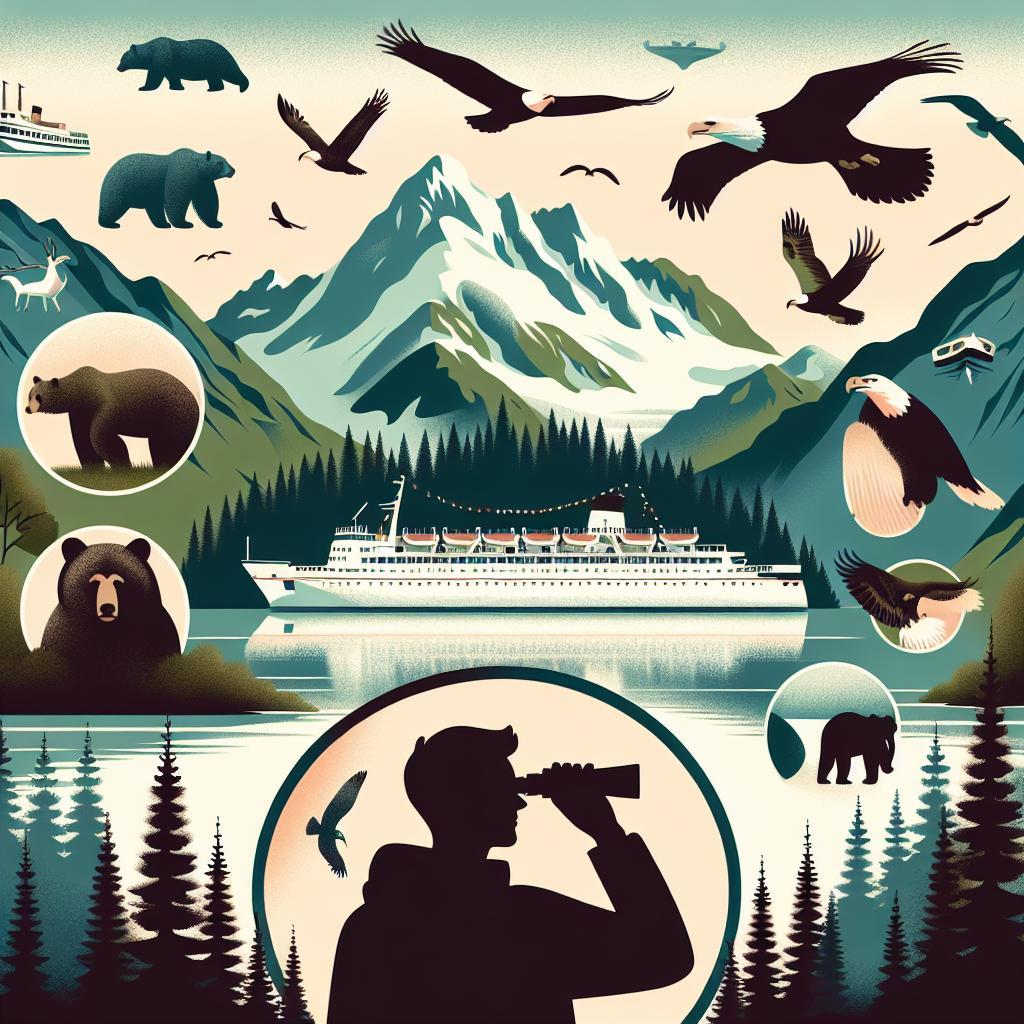Exploring the Last Frontier: Wildlife Watching on an Alaskan Cruise
As the ship glides through the shimmering waters of the Inside Passage, a world of wonder unfolds beyond the deck. Towering glaciers and rugged coastlines set the stage for one of nature’s grand performances—wildlife watching in Alaska, where the wild still reigns supreme. From majestic humpback whales breaching the surface to the graceful glide of bald eagles overhead, every moment spent in this untamed paradise reveals the intricate tapestry of wildlife that calls Alaska home. An Alaskan cruise offers not just a journey through breathtaking landscapes but an opportunity to witness the raw beauty and diversity of life that thrives in one of the most remote corners of the earth. Join us as we embark on an adventure that promises encounters with the extraordinary, inviting you to immerse yourself in the breathtaking spectacle of nature’s show in this remarkable region.
Exploring Magnificent Marine Life in Alaskas Coastal Waters
Alaska’s coastal waters are a mesmerizing tapestry of life, offering countless opportunities for wildlife watching that beckons adventurers and nature lovers alike. As you cruise through the tranquil fjords, get ready to be enchanted by the magnificent array of marine species that inhabit this breathtaking region. Keep your eyes peeled for orcas, the sleek humpback whales, and the playful sea otters that frolic on the surface. Additionally, watch for the giant Steller sea lions basking on rocky shores, adding a splash of personality to the rugged landscape.
Exploring these pristine waters reveals a vibrant ecosystem comprising various fish and avian species. Here are some highlights you may experience on your journey:
- Avian Wonders: Spot the graceful bald eagle, a symbol of America, as it soars above or stoops down to catch a meal.
- Colorful Fish: Witness schools of salmon, which are vital to the region’s ecosystem and a favorite among fishermen.
- Unique Invertebrates: Delve into the depths as you encounter vibrant starfish and ethereal jellyfish dancing with the currents.
To enhance your experience, consider joining a guided wildlife tour, where expert naturalists can provide insight into the behaviors and habitats of the enchanting creatures you encounter. A typical tour might cover various sites, including:
| Site | Description |
|---|---|
| Glacier Bay | Famous for its dramatic glaciers and diverse marine life. |
| Kenai Fjords | A stunning landscape with opportunities to see orcas and puffins. |
| Prince William Sound | A haven for wildlife, featuring lush greenery and serene waters. |

Encountering Majestic Land Animals in Their Natural Habitats
Embarking on an Alaskan cruise offers a breathtaking opportunity to witness majestic land animals in their natural habitats. As the ship glides through the crystal-clear waters surrounded by towering mountain peaks, sightings of wildlife become unforgettable moments etched in memory. Expect to encounter a variety of species, each exhibiting their unique behaviors against the backdrop of stunning landscapes. Some of the remarkable encounters include:
- Grizzly Bears: View these powerful creatures foraging for food along riverbanks.
- Moose: Spot these gentle giants grazing peacefully in lush meadows.
- Mountain Goats: Watch them skillfully navigate the rocky terrains of steep cliffs.
- Wolves: Experience the excitement of seeing a pack wandering through pristine forests.
To enhance the wildlife viewing experience, many cruises offer guided excursions that allow passengers to venture deeper into specific regions known for animal sightings. These excursions often incorporate knowledgeable guides who share valuable insights about the local ecosystems and conservation efforts. Some highlights you may experience include:
| Wildlife Type | Best Viewing Locations | Best Time to See |
|---|---|---|
| Grizzly Bears | Katmai National Park | July – September |
| Moose | Denali National Park | May - August |
| Mountain Goats | Chugach State Park | Spring and Early Summer |
| Wolves | Wrangell-St. Elias National Park | Year-Round |

Understanding the Best Times and Locations for Wildlife Sightings
To maximize your wildlife watching experience on an Alaskan cruise, timing is key. Certain seasons offer unique opportunities to observe different species in their natural habitats. For instance, spring is ideal for spotting migratory birds returning to the region, as well as whales that are active during their feeding season. By contrast, summer provides optimum viewing conditions for several marine mammals, including orcas and humpback whales, as they swim near coastal areas. Engaging with crew members or local guides can enhance your understanding of the wildlife patterns and help you catch sight of elusive animals.
When it comes to locations, certain hotspots stand out for their diverse ecosystems. Here are a few areas to consider for your wildlife adventures:
- Glacier Bay National Park - A fantastic place for whale watching and spotting sea otters.
- Kenai Fjords National Park – Known for its rich marine life, including puffins and seals.
- Prince William Sound - Perfect for observing a wide variety of seabirds and even the occasional brown bear.
- Chilkoot Lake – Offers great opportunities to see salmon spawning in late summer.

Tips for Responsible Wildlife Viewing and Photography on Your Cruise
Embarking on a cruise through the stunning Alaskan wilderness presents a golden opportunity to observe wildlife in their natural habitat. However, to ensure a respectful and memorable experience for both you and the animals, following a set of guidelines is essential. Here are some fundamental tips:
- Keep a Respectful Distance: Always maintain a safe distance from wildlife. This helps protect both the animals and yourself, ensuring they feel secure while allowing you to enjoy unobstructed views.
- Minimize Noise: Animals are sensitive to sound. Keep your voice down and avoid loud equipment to not startle wildlife.
- Use Telephoto Lenses: When photographing, opt for a telephoto lens to capture incredible close-ups without intruding on the animal’s space.
- Avoid Touching or Feeding Wildlife: Engaging physically with wildlife can be harmful to their well-being and disrupt natural behaviors.
Moreover, supporting local conservation efforts enhances your wildlife watching experience while preserving the environment. Consider the following suggestions:
| Action | Benefit |
|---|---|
| Purchase Local Guides | Strengthens community conservation initiatives |
| Join Eco-Friendly Tours | Promotes sustainable wildlife viewing practices |
| Report Disturbances | Helps authorities protect wildlife and habitats |
By embracing these responsible practices, you can enjoy breathtaking wildlife encounters while ensuring that these magnificent creatures remain safe and flourishing in their natural surroundings.
To Conclude
As your Alaskan adventure comes to a close, the memories of majestic whales breaching the icy blue waters, playful sea otters lounging on sun-soaked shores, and the sight of soaring eagles against a backdrop of towering glaciers will remain etched in your heart. The pristine wilderness of Alaska, with its captivating landscapes and vibrant ecosystems, offers an unparalleled opportunity to connect with nature and witness the breathtaking beauty of wildlife in their natural habitat.
Whether you found yourself mesmerized by the rhythmic dance of salmon swimming upstream or captivated by the serene grace of a mother bear with her cubs, each moment spent wildlife watching has the power to inspire a deeper appreciation for our planet’s delicate balance. As you prepare to leave the last frontier behind, carry with you the spirit of adventure and a renewed commitment to protecting the incredible wildlife that you encountered.
The call of the wild may linger in your thoughts, but it is up to you to share the stories of your experiences, fostering a sense of responsibility and wonder in those around you. Until your next journey into the wild, let the memory of Alaska’s awe-inspiring creatures remind you that every ecosystem is a treasure worth cherishing and protecting. Safe travels, and may your path be filled with more wild wonders in the future.

